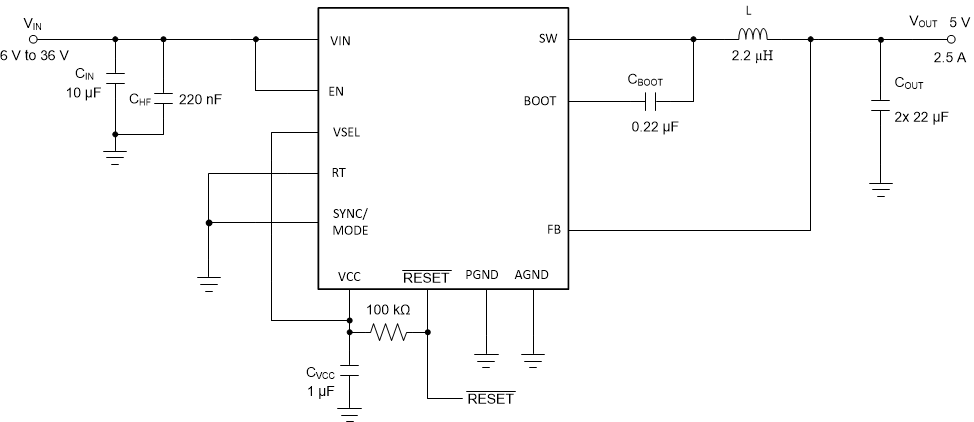SNVSB55H February 2019 – June 2024 LM63615-Q1 , LM63625-Q1
PRODUCTION DATA
- 1
- 1 Features
- 2 Applications
- 3 Description
- 4 Device Comparison Table
- 5 Pin Configuration and Functions
- 6 Specifications
- 7 Detailed Description
- 8 Application and Implementation
- 9 Device and Documentation Support
- 10Revision History
- 11Mechanical, Packaging, and Orderable Information
8.2 Typical Application
Figure 8-1 shows a typical application circuit for the LM636x5D-Q1. This device is designed to function over a wide range of external
components and system parameters. However, the internal compensation is optimized for a
certain range of external inductance and output capacitance. As a quick start guide, see Table 8-1 and
Table 8-2 for typical component values.
 Figure 8-1 Example Application Circuit VIN = 12 V, VOUT = 5 V, IOUT = 2.5 A, ƒSW = 2.1 MHz
Figure 8-1 Example Application Circuit VIN = 12 V, VOUT = 5 V, IOUT = 2.5 A, ƒSW = 2.1 MHzTable 8-1 Typical External Component Values for 1.5-A Output Current
| ƒSW (kHz) | VOUT | L (µH)(1) | TYPICAL(2) COUT | MINIMUM(2) COUT | VSEL | RT | CIN | CBOOT | CVCC |
|---|---|---|---|---|---|---|---|---|---|
| 400 | 3.3 | 10 | 4 × 10 µF | 2 × 10 µF | AGND | VCC | 4.7 µF + 220 nF | 220 nF | 1 µF |
| 2100 | 3.3 | 4.7 | 2 × 10 µF | 1 × 10 µF | AGND | AGND | 4.7 µF + 220 nF | 220 nF | 1 µF |
| 400 | 5 | 10 | 4 × 10 µF | 2 × 10 µF | VCC | VCC | 4.7 µF + 220 nF | 220 nF | 1 µF |
| 2100 | 5 | 4.7 | 2 × 10 µF | 1 × 10 µF | VCC | AGND | 4.7 µF + 220 nF | 220 nF | 1 µF |
(1) See Section 8.2.2.3.
(2) See Section 8.2.2.4.
Table 8-2 Typical External Component Values for 2.5-A Output Current
| ƒSW (kHz) | VOUT | L (µH)(1) | TYPICAL(2) COUT | MINIMUM(2) COUT | VSEL | RT | CIN | CBOOT | CVCC |
|---|---|---|---|---|---|---|---|---|---|
| 400 | 3.3 | 6.8 | 3 × 22 µF | 2 × 22 µF | AGND | VCC | 4.7 µF + 220 nF | 220 nF | 1 µF |
| 2100 | 3.3 | 2.2 | 2 × 22 µF | 1 × 22 µF | AGND | AGND | 4.7 µF + 220 nF | 220 nF | 1 µF |
| 400 | 5 | 6.8 | 3 × 22 µF | 2 × 22 µF | VCC | VCC | 4.7 µF + 220 nF | 220 nF | 1 µF |
| 2100 | 5 | 2.2 | 2 × 22 µF | 1 × 22 µF | VCC | AGND | 4.7 µF + 220 nF | 220 nF | 1 µF |
(1) See the Section 8.2.2.3.
(2) See the Section 8.2.2.4.